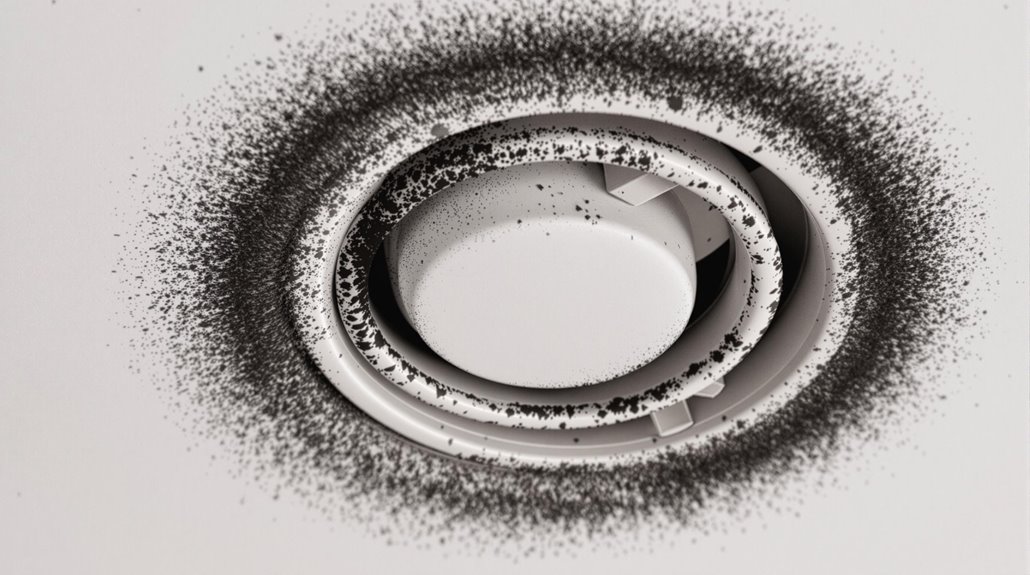While black dust around air vents may seem like a minor nuisance, I’ve discovered it can signal serious problems with your home’s air quality and HVAC system. I’ve spent years helping homeowners tackle this common issue, which often appears as mysterious dark smudges around vents and can spread to nearby walls and furniture. If you’re noticing these telltale signs in your home, you’ll want to understand what’s causing it before it becomes a bigger problem.
What Is Black Dust and Why Does It Form Around Air Vents?

The black dust accumulating around your air vents is typically a mixture of dirt, soot, pet dander, pollen, and other airborne particles that get trapped in your HVAC system.
I’ve found that this black dust composition often includes microscopic rubber particles from tires, carbon from vehicle emissions, and even fungal spores that travel through outdoor air.
When your HVAC system runs, it creates negative pressure that pulls these particles toward your vents, where they stick to surfaces due to static electricity and moisture.
I want you to know that while some dust is normal, excessive black dust could indicate poor air quality or dirty air ducts.
If you’re seeing substantial buildup, it’s important to contemplate both regular cleaning and having your ducts professionally inspected to protect your family’s health.
Common Sources of Black Dust in Your Home
While most homeowners notice black dust around their vents, I’ve found that several common indoor sources contribute greatly to this unsightly buildup throughout your home.
The biggest culprits I regularly see include candle soot, fireplace ash, and various indoor pollutants from cooking and cleaning products.
Your furniture materials can release tiny particles as they break down, especially older upholstery, carpets, and foam cushions.
I’ve noticed that rubber and plastic items, like shoe soles and electronic equipment, also shed microscopic black particles.
Pet dander, skin cells, and textile fibers combine with carbon-based particles from outside traffic exhaust that sneaks in through windows and doors.
In homes with older HVAC systems, deteriorating ductwork insulation often adds to this dusty mix.
Health Risks Associated With Black Dust Buildup
Because black dust accumulation around vents often contains harmful particles, I’ve seen it trigger various respiratory issues in my clients’ homes and families.
The health implications can be quite serious, especially for people with asthma, allergies, or compromised immune systems.
When you breathe in black dust, it can irritate your lungs, cause coughing fits, and lead to chronic breathing problems.
I’ve noticed that children and elderly family members are particularly vulnerable to these airborne contaminants.
You might experience headaches, sinus congestion, or even skin irritation if you’re regularly exposed to vent dust.
If you’re seeing black dust around your vents, don’t ignore it – your family’s health could be at risk.
I always tell my clients that prevention through regular cleaning is much better than dealing with respiratory issues later.
Essential Tools and Supplies for Cleaning Air Vents

Gathering proper cleaning supplies makes tackling black dust around air vents much more manageable and effective.
I recommend starting with a vacuum cleaner that has attachments, including a soft brush head and crevice tool for reaching tight spaces.
For your cleaning supplies, you’ll need microfiber cloths, an all-purpose cleaner that’s safe for your vent material, and a bucket of warm water.
I also suggest having dusting tools like an extendable duster or a soft-bristled brush for initial dust removal.
Don’t forget to grab a screwdriver to remove vent covers, protective gloves to keep your hands clean, and disposable face masks to avoid inhaling particles while you work.
If you’re dealing with high vents, you’ll also want a sturdy stepladder for safe access.
Step-by-Step Guide to Removing Black Dust
Now that you’ve got your cleaning supplies ready, let’s start removing that stubborn black dust from your air vents with a systematic approach.
I’ll guide you through proven cleaning techniques that will help restore your vents to pristine condition while keeping you safe during the dust removal process.
- Turn off your HVAC system completely, put on your protective mask and gloves, and remove the vent cover by unscrewing it carefully from the wall or ceiling.
- Spray your cleaning solution onto a microfiber cloth (never directly into the vent), and wipe down both sides of the vent cover, paying special attention to the spaces between the slats.
- Using your vacuum’s brush attachment, gently clean about six inches into the duct opening, moving in steady, careful strokes to avoid damaging the ductwork.
Preventive Measures to Minimize Black Dust Accumulation
While regular cleaning helps keep black dust at bay, implementing preventive measures can greatly reduce how often you’ll need to tackle those grimy vents in the first place.
I recommend starting with consistent air filter maintenance – replace or clean your HVAC filters every 1-3 months, depending on your home’s conditions.
I’ve found that setting calendar reminders helps me stay on track. Additionally, I suggest sealing any duct leaks, scheduling professional HVAC maintenance yearly, and using high-quality pleated filters rated MERV 8 or higher.
Consider installing a whole-house air purifier, which I’ve seen make a significant difference in reducing airborne particles.
Don’t forget about regular cleaning of your home’s surfaces, especially around vents, to prevent dust from getting pulled into your HVAC system.
When to Call a Professional HVAC Technician

Despite your best DIY cleaning efforts, there are several key situations when I’d strongly recommend calling in a professional HVAC technician to address black dust issues. Signs indicating you need professional assessment include persistent black dust that quickly returns after cleaning, unusual odors, or visible mold growth around your vents.
- When you notice the black dust is accompanied by strange noises from your ductwork, like whistling or rattling, which could signal deeper system problems.
- If you’re experiencing unexplained respiratory issues, headaches, or allergic reactions that worsen when your HVAC system is running.
- When black dust appears shortly after completing routine maintenance, suggesting potential issues with your system’s filtration or ductwork that require specialized inspection tools and expertise.







